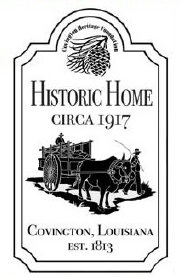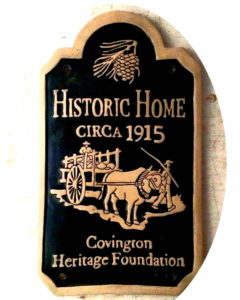 The Covington Heritage Foundation is offering residents an opportunity to play a part in the preservation and recognition of Covington’s turn-of-the-century architectural history.
The Covington Heritage Foundation is offering residents an opportunity to play a part in the preservation and recognition of Covington’s turn-of-the-century architectural history.
CELEBRATE YOUR HOME’S ARCHITECTURAL HISTORY
Covington is blessed to have so many turn-of-the-20th century homes rich in character and charm. As part of our mission, CHF created the Preserving Historic Covington Program to recognize owners of such homes and help preserve and celebrate Covington’s architectural history by displaying a CHF Historic Home Plaque.
Historic designation is determined by age as calculated using courthouse records and maps*, and a visual survey of the home’s condition, design, and integrity. The plaques are made by Nicholas Hasslock, son of Tika and Steve Hasslock of the former Hasslock Studios.**
Join your neighbors and order today! For $200 you will receive your home’s complete history, a current photo, and a CHF Historic Home Plaque. Orders are taken twice a year around October and March. Production of the plaques take about six weeks. Contact us for info and ordering at CovingtonHistoricHomes@gmail.com.
*Sanborn Fire Insurance Map of 1927 is one of the maps used for research.
Check out this website for info on Sanborn Maps:
http://www.citylab.com/housing/2014/10/theaccidental-revelations-of-sanborn-maps/381262
**A 2017 article on Nicholas by Ron Barthet is most interesting. It more or less states how Nicholas became the artist he is. Nicholas is the son of Tika and Steve Hasslock who are know for their beautiful ceramic pieces throughout the country. Nicholas’s story goes like this:
While working the booth of Hasslock Studios at Jazz Fest 2006, Nicholas was approached by a city architect who was at a loss to find replacement tiles for the sidewalks. The architect inquired whether Nicholas knew of anyone who cold make the ceramic lettered tiles that spell out the names of the streets on nearly every corner in New Orleans. After not being able to refer him to anyone, Nicholas suggested himself and that he would be honored to give it a shot. Close to a year later, local contractor, Boh Bros., contacted and commissioned Nicholas for the job.
Over the net two years at his studio in the Marigny, Nicholas worked on perfecting the recipe for perfecting thee recipe for vitrification, the process by which clay becomes non-porous and glass-like. It was one tough and necessary challenge to give these tiles the integrity to withstand the wear and weather of the heavily used sidewalks. The new tiles are the only traditionally accurate replacement tiles that equally match the durability and color.
Matching the exact colors of the original tiles was a key factor, something that took an artist’s eye. “You just can’t pull any color off the shelf and use it,” he says. The original tiles were made in Alhambra, Spain and installed around the 1920s.
Quarterly Meetings:
All quarterly meetings are open to all members on the second Tuesdays of March, June and September at 11 am at the Covington Trailhead Museum, 419 N. New Hampshire Street.
Books by CHF Members about Covington:
Stories of a River Town
by C. Howard Nichols
Stories of a Rivertown: Covington, Louisiana at 200 Years, may be purchased through the Covington Heritage Foundation for $35. Send an email to covingtonheritagefoundation@

African American’s In Covington
by Eva Semien Baham, Rev. Mallery Callahan
Covington is the seat of St. Tammany Parish government and sits north of Lake Pontchartrain in the New Orleans metropolitan area. Records from 1727 show 11 Africans on the north shore. One person of African descent was present at the founding of Covington on July 4, 1813. Most African Americans in antebellum Covington were slaves, with a modest number of free people, all of whom covered nearly every occupation needed for the development and sustenance of a heavily forested region. For more than 200 years in Covington, African Americans transformed their second-class status by grounding themselves in shared religious and social values. They organized churches, schools, civic organizations, benevolent societies, athletic associations, and businesses to address their needs and to celebrate their joys.
Author Bio: Looking back in time, author Eva Semien Baham traces the core of Covington’s African American community members to their faiths’ emphases on timeless endurance, perseverance, and active work for change. Residents have a rich history and a contemporary experience rooted in both spiritual and civic involvement on behalf of the social, cultural, and economic advancement of their community, town, and country.


